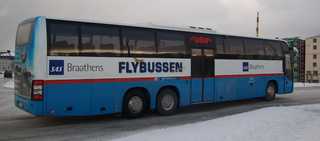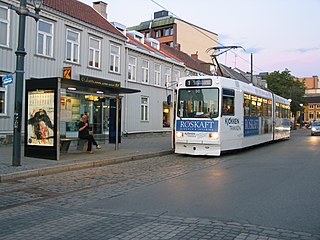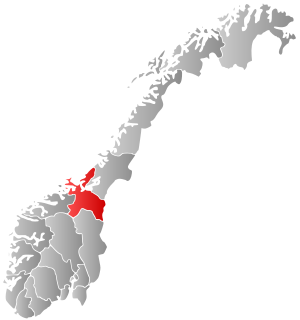
Norges Statsbaner AS, trading as NSB AS and known in English as the Norwegian State Railways, is a government-owned railway company which operates most passenger train services in Norway. Owned by the Norwegian Ministry of Transport and Communications, it is also engaged in real estate through Rom Eiendom, bus transport through Nettbuss, cargo trains through CargoNet and Swedish train transport through Tågkompaniet. NSB transported 52 million train passengers and 104 million bus passengers in 2009. The current company was established on 1 December 1996, when the former Norwegian State Railways (1883–1996) was split into the new NSB, the infrastructure company the Norwegian National Rail Administration and the Norwegian Railway Inspectorate. In 2002 the freight operations were split to the subsidiary CargoNet, and the maintenance department became Mantena.

The Gråkallen Line is an 8.8-kilometre (5.5 mi) suburban tram line located in Trondheim, Norway. As the only remaining part of the Trondheim Tramway, it runs from the city centre at St. Olav's Gate, via the suburban area Byåsen to Lian. It is designated Line 1, and is served by six Class 8 articulated trams. After the closure of the Arkhangelsk tramway in 2004, it became the world's northernmost tramway system.

Nettbuss AS is the largest bus company in Norway, owned by the Norwegian State Railways (NSB). It was established on 10 February 2000 as the continuation of the bus operations from former NSB Biltrafikk. In addition to bus services in major parts of Norway, it also operates buses in Sweden through subsidiaries.
TrønderBilene AS is a bus company operating in Trøndelag, Norway. As of 2009, it has 324 employees and 238 buses, and is owned by Torghatten ASA. The company operates both coach, bus, charter and school routes, as well as some truck and garage services. The areas of operation are Innherred, Namdalen, Fosen, Hitra and Frøya. TrønderBilene runs three town bus services: Buster in Steinkjer, Blåmann in Levanger and Verdalsøra, and Elgen in Namsos. The coach service from Namsos to Trondheim is part of NOR-WAY Bussekspress.

Trondheim Central Station or Trondheim S is the main railway station serving the city of Trondheim, Norway. Located at Brattøra in the north part of the city centre, it is the terminus of the Dovre Line, running southwards, and the Nordland Line, which runs north. The railway is electrified south of the station but not north of it, so through trains must change locomotives at the station.

Boreal Bane AS, trading, and formerly known as, AS Gråkallbanen, is a Norwegian company that operates the remaining part of the Trondheim Tramway, Norway. It operates six trams on the Gråkall Line, that connects the city centre to parts of the suburb of Byåsen, and the recreational area at Lian. It has 800,000 annual passengers, and operates as Line 1. The trams operate each 15 minutes during the day, and each 30 minutes in the evenings and during the weekends.

The Trondheim Tramway in Trondheim, Norway, is the world's most northerly tramway system, following the closure and dismantling of the Arkhangelsk tramways in Russia. It consists of one 8.8-km-long line, the Gråkallen Line, running from St. Olav's Gate in the city centre through Byåsen to Lian Station in Bymarka.

Team Trafikk AS was the bus company in Trondheim, Norway, since 2002 owned by Nettbuss. The company had 225 buses, 600 employees, a revenue of NOK 270 million and a daily ridership of ca 70,000 passengers in 2005. The company received subsidies from the City of Trondheim for their operations.

The Singsaker Line was a branch of the Trondheim Tramway which ran from Øya and Elgeseter to the neighborhoods of Singsaker, parts of Tyholt and Rosenborg in Trondheim, Norway. The line branched off from the Elgeseter Line at the Student Society. It was double track until Tyholtveien, after which it ran through a loop through Rosenborg. It was served by Line 3, which continued through the city center to Trondheim Central Station.
A/S Graakalbanen was a private company that built and operated the Gråkallen Line of the Trondheim Tramway between 1924 and 1972. Established in 1916, it bought large land areas in Byåsen, and built a tramway through these to reach the recreational areas in Bymarka. The line first reached Munkvoll in 1924, Ugla in 1925, and finally Lian in 1933. The company owned through its history seven trams and five trailers, and only in the last few years did it operate six borrowed TS Class 7 trams.

The Lade Line was a tramway between Munkegata and Lade in Trondheim, Norway. The first part of the line was opened in 1901, but not expanded to Lade until 1958. The line was operated by Trondheim Sporvei and Trondheim Trafikkselskap until it was abandoned in 1988.

Klæburuten is a Norwegian bus company located in Trondheim. It operates the regional buses in Klæbu and to Trondheim in addition to the Airport Bus from Trondheim to Trondheim Airport, Værnes.
Unibuss, formerly known as AS Sporveisbussene and Nexus Trafikk, is a Norwegian bus company based in Oslo, Norway. It is a subsidiary of the municipal public transport group Sporveien, and was created in 2003 to allow the company to compete for the public service obligation (PSO) contracts through which Oslo was to operate its bus system. In 2017 Unibuss carried 98 million passengers on 759 buses operating on 203 routes and covering a total annual road distance of almost 41.4 million kilometres. With 1860 employees, the company had an operating income in that year of NOK 1684 million.

Devon General was the principal bus operator in south Devon from 1919. The name was first used by the Devon General Omnibus and Touring Company which was created in 1919. In 1922 it was purchased by the National Electric Construction Company which merged with British Electric Traction in 1931. Nationalisation in 1969 resulted in 1971 with the company being merged into Western National. In 1983 a new Devon General Limited was created which became the first operating subsidiary of the National Bus Company to be privatised in 1986 when it became the first company of Transit Holdings. It was sold to the Stagecoach Group in 1996 and renamed Stagecoach Devon in 2003.
Trondhjems Omnibus Aktieselskab was the first provider of public transport in Trondheim, Norway. From 1893 to 1902, it operated a horse-hauled coach service in Trondheim. Until 1901 it operated the profitable Voldsminde–Ila route, but then the Trondheim Tramway took over the route, and the company was forced to operate a less profitable route from the railway station to Øya. The company went bankrupt the following year.

The Trondheim Tramway controversy regards the political discussion of whether Trondheim, Norway, should have a tramway.
Hønefoss Jernbanevogn- og Karosserifabrikk A/S, trading as Høka and at first known as Hønefoss Karosserifabrikk A/S, was a manufacturer of bodywork for buses, trucks and trains. The company was in existence from 1936 to 1968 and was based in Hønefoss, Norway. Among the company's products is Oslo Tramway's SM53 trams, the Trondheim Tramway's GB Class 3 tram and the Norwegian State Railways Skd 221 shunters.














